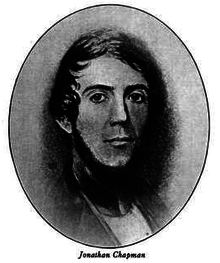Jonathan Chapman
| Jonathan Chapman | |
|---|---|
 | |
| 8th Mayor of Boston, Massachusetts | |
|
In office 1840–1842 | |
| Preceded by | Samuel A. Eliot |
| Succeeded by | Martin Brimmer |
| Member of the Common Council of Boston, Massachusetts[1] | |
|
In office 1838[1] – 1838[1] | |
| Member of the Common Council of Boston, Massachusetts[1] | |
|
In office 1835[1] – 1836[1] | |
| Personal details | |
| Born | January 23, 1807 |
| Died | May 25, 1848 (aged 41)[2] |
| Political party | Whig[3] |
| Spouse(s) | Lucinda Dwight (Born July 7, 1809; Married April 25, 1832)[1][4] |
| Children | Jonathan Chapman (b. March 11, 1836); Eliza Chapman (b. March 10, 1838)[5] |
| Alma mater | Phillips Exeter Academy [1]Harvard,[2] class of 1825.[1] |
| Profession | Attorney[1][2] |
| Image from Mayors of Boston: An Illustrated Epitome of who the Mayors Have Been and What they Have Done, Page 16 Boston, MA: State Street Trust Company, 1914. | |
Jonathan Chapman (January 23, 1807 – May 25, 1848) was an American politician, serving as the eighth mayor of Boston, Massachusetts from 1840 to 1842.
Chapman's father also named Jonathan Chapman served as a member of the Town of Boston's Board of Selectmen.
Chapman attended Philips Exeter Academy and he graduated from Harvard College and studied law under the direction of Judge Lemuel Shaw.
Chapman was elected Mayor in December 1839, he was sworn into office in 1840, he served three one year terms.[2]
Because of a large increase of the debt of the city of Boston in the 18 years since it was incorporated, Mayor Chapman had as a chief aim of his administration the reduction of the city's debt.[2]
New City Hall
Although land had been purchased for a new city hall, Mayor Chapman did not favor that project. Because Suffolk County was constructing a new building for the Registry and Probate offices, and was going to move out of the old courthouse building, Chapman instead recommended that the old Suffolk County Courthouse be remodeled for use as Boston's city hall.[6]

The City occupied the renovated structure on March 18, 1841.[2]
Steamship Service
Chapman spoke of the great importance of the establishment of the Cunard Lines[2] steamship[7] service between Boston and Liverpool, England.
The Western Railroad
Chapman also spoke of the great importance of the opening up of the Western Railroad from Boston to the Hudson River.[2][7]
See also
- Timeline of Boston, 1830s–1840s
References
- Image from Mayors of Boston: An Illustrated Epitome of who the Mayors Have Been and What they Have Done, Boston, MA: State Street Trust Company, Page 16, (1914).
Notes
- 1 2 3 4 5 6 7 8 9 10 Boston Directory for the Year 1851, Boston, MA: George Adams, 1851, p. 8 External link in
|title=(help) - 1 2 3 4 5 6 7 8 Mayors of Boston: An Illustrated Epitome of who the Mayors Have Been and What they Have Done, Boston, MA: State Street Trust Company, 1914, p. 15
- ↑ Winsor, Justin (1881), The Memorial History of Boston, Volume III, Boston, MA: Ticknor and Company, p. 247
- ↑ Dwight, Benjamin Woodbridge (1874), The History of the Descendants of John Dwight, of Dedham, Mass Vol. 2, New York, NY: Benjamin Woodbridge Dwight (printed by John P. Trow and Sons), p. 893
- ↑ Dwight, Benjamin Woodbridge (1874), The History of the Descendants of John Dwight, of Dedham, Mass, Vol. 2, New York, NY: Benjamin Woodbridge Dwight (printed by John P. Trow and Sons), p. 893
- ↑ Koren, John (1922), Boston, 1822 to 1922: The Story of Its Government And Principal Activities During One Hundred Years, Boston, MA: City of Boston Printing Department, pp. 26–27
- 1 2 Koren, John (1922), Boston, 1822 to 1922: The Story of Its Government And Principal Activities During One Hundred Years, Boston, MA: City of Boston Printing Department, p. 26
| Political offices | ||
|---|---|---|
| Preceded by Samuel A. Eliot |
Mayor of Boston, Massachusetts 1840–1842 |
Succeeded by Martin Brimmer |